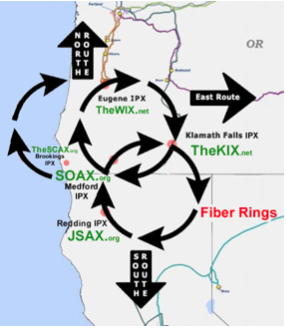Local Internet Edge Network (LIEN) Modernizing the current internet infrastructure with the State Of Oregon
David Hand has been involved in the Oregon Telecommunications business as long as I have, well over 25 years.
Over the years he has built a successful ISP (Mighty.Net) with his partners, as well as a data center in Southern Oregon (Data Center West) with Co-Lo operations in Ashland, Medford, Redding and Eugene. In 2012 he worked hard to get all of the Southern Oregon ISPs to peer exchange in his head-end under the banner of RogueNexus.
Unlike me, he has spent his career laser focused on telecommunications in Southern Oregon.
I saw him in attendance on a recent “So OR Broadband Touchpoint” Zoom call put on by Marta at Biz Oregon and I pinged him in chat to see if we could connect after the call.
The hours we spent in Zoom spread over the next two days is a blur. His rapid flow of ideas is fun and always intriguing.
When I asked him what he was working on now he told me about LIEN – The Local Internet Edge Network.

It’s the next generation of the local peering exchange he championed a decade ago. From what I can understand he seeks to improve the speed and reliability of the internet by creating one local network in each part of Oregon (a local network directly peered with all local telecommunication carrier networks). In turn, these state wide Local Internet Edge Networks (LIEN) are then interconnected together maximizing the speed and flexibility of all regional telecommunications networks.
Why do this? Because the Oregon telecommunications’ fiber infrastructure current top down design model is outdated. Imagine that we have no local roadways or local freeway exits and that every time we wanted to drive between Ashland and Medford we were required to drive to Portland first only to turn around and drive back south to Medford. Imagine this is how we travel to see our doctor or access critical information. Now imagine how much faster, more efficient, smarter and reliable accessing online resources would be utilizing a local roadway, a local fiber telecommunications infrastructure? If there was a failure of the internet due to catastrophe such as fire or earthquake, he believes people and businesses in Southern Oregon would be cut off.
To make the internet faster/more reliable we must reduce the network latency and the number of points of failure.
The goal is to modernize the current WWW by enabling local internet traffic to remain local and return
telecommunications back to carrier grade design that was a requirement back in the day of POTS and dial tone.
He is reaching out to anyone that has power over the state’s internet and pursestrings and trying to get them to understand.
I think I understood enough to share this with you and to commit to him that I will research more to see if this is in fact the case and help him get the word out.
The challenge is that we are all building more and more systems on to the “cloud” for many good reasons. David believes that we give up access in times of emergency. Critical data is useless if you can’t get to the cloud. One example of this are the cameras I donated space on my towers and bandwidth for forest fire watching remotely. The videos are stored on the cloud and fire professionals access them from anywhere.
He is passionate about this and will be working hard to make sure we all know that a very small portion of the federal funds that are coming for broadband will be well spent on making the Local Internet Edge Network a reality.
David can be reached at DHand@datacenterwest.com if you would like to learn more.


Advertisement